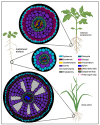Lost in translation: What we have learned from attributes that do not translate from Arabidopsis to other plants
- PMID: 40371945
- PMCID: PMC12079428
- DOI: 10.1093/plcell/koaf036
Lost in translation: What we have learned from attributes that do not translate from Arabidopsis to other plants
Abstract
Research in Arabidopsis thaliana has a powerful influence on our understanding of gene functions and pathways. However, not everything translates from Arabidopsis to crops and other plants. Here, a group of experts consider instances where translation has been lost and why such translation is not possible or is challenging. First, despite great efforts, floral dip transformation has not succeeded in other species outside Brassicaceae. Second, due to gene duplications and losses throughout evolution, it can be complex to establish which genes are orthologs of Arabidopsis genes. Third, during evolution Arabidopsis has lost arbuscular mycorrhizal symbiosis. Fourth, other plants have evolved specialized cell types that are not present in Arabidopsis. Fifth, similarly, C4 photosynthesis cannot be studied in Arabidopsis, which is a C3 plant. Sixth, many other plant species have larger genomes, which has given rise to innovations in transcriptional regulation that are not present in Arabidopsis. Seventh, phenotypes such as acclimation to water stress can be challenging to translate due to different measurement strategies. And eighth, while the circadian oscillator is conserved, there are important nuances in the roles of circadian regulators in crop plants. A key theme emerging across these vignettes is that even when translation is lost, insights can still be gained through comparison with Arabidopsis.
© The Author(s) 2025. Published by Oxford University Press on behalf of American Society of Plant Biologists.
Conflict of interest statement
M.A.H. is an employee of BASF and owns shares in companies that sell agricultural products. The views of M.A.H expressed here are personal.
Figures








Similar articles
-
Genetic variation, environment and demography intersect to shape Arabidopsis defense metabolite variation across Europe.Elife. 2021 May 5;10:e67784. doi: 10.7554/eLife.67784. Elife. 2021. PMID: 33949309 Free PMC article.
-
Evolution of RLSB, a nuclear-encoded S1 domain RNA binding protein associated with post-transcriptional regulation of plastid-encoded rbcL mRNA in vascular plants.BMC Evol Biol. 2016 Jun 29;16(1):141. doi: 10.1186/s12862-016-0713-1. BMC Evol Biol. 2016. PMID: 27356975 Free PMC article.
-
Evolutionary origins of Brassicaceae specific genes in Arabidopsis thaliana.BMC Evol Biol. 2011 Feb 18;11:47. doi: 10.1186/1471-2148-11-47. BMC Evol Biol. 2011. PMID: 21332978 Free PMC article.
-
Decoding plant specialized metabolism: new mechanistic insights.Trends Plant Sci. 2024 May;29(5):535-545. doi: 10.1016/j.tplants.2023.11.015. Epub 2023 Dec 9. Trends Plant Sci. 2024. PMID: 38072690 Review.
-
Challenges of translating Arabidopsis insights into crops.Plant Cell. 2025 May 9;37(5):koaf059. doi: 10.1093/plcell/koaf059. Plant Cell. 2025. PMID: 40178150 Free PMC article. Review.
Cited by
-
In defense of funding foundational plant science.Plant Cell. 2025 May 9;37(5):koaf106. doi: 10.1093/plcell/koaf106. Plant Cell. 2025. PMID: 40324389 Free PMC article.
-
Focus on Translational Research from Arabidopsis to Crop Plants and Beyond.Plant Cell. 2025 May 9;37(5):koaf119. doi: 10.1093/plcell/koaf119. Plant Cell. 2025. PMID: 40373203 Free PMC article. No abstract available.
References
Publication types
MeSH terms
Grants and funding
LinkOut - more resources
Full Text Sources
Miscellaneous

